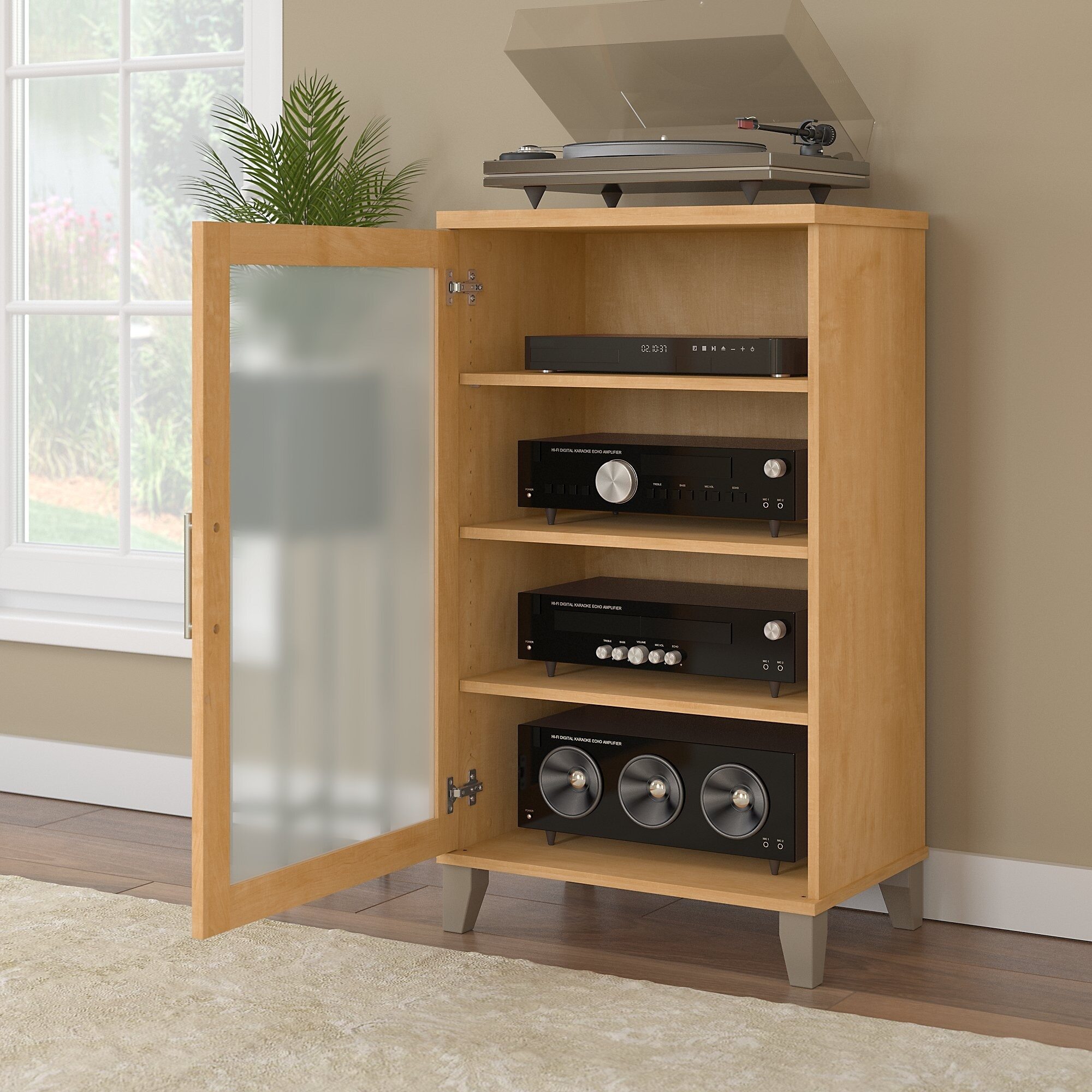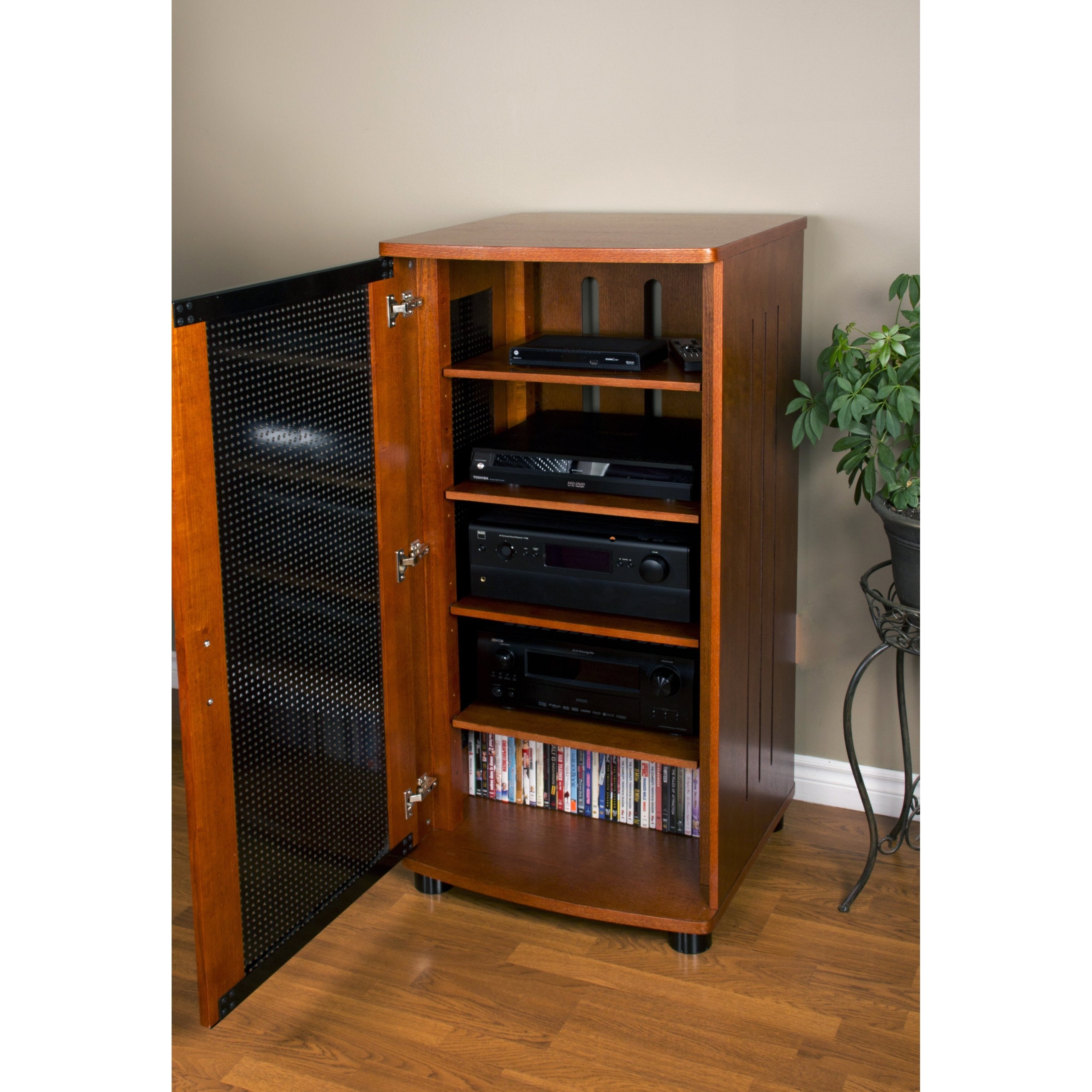The Allure of Wood Audio Cabinets

Wood has been a cornerstone of furniture making for centuries, and its use in audio cabinets is a testament to its enduring appeal. From the warmth and elegance of vintage record players to the sleek sophistication of modern high-fidelity systems, wood cabinets have consistently played a vital role in shaping the sonic landscape.
The Historical Significance of Wood in Audio Cabinets
Wood’s journey in audio cabinets dates back to the early days of recorded music. In the late 19th and early 20th centuries, as phonographs and gramophones gained popularity, wood was the primary material used for cabinet construction. Its inherent properties, including its ability to dampen vibrations and its natural resonance, made it an ideal choice for housing delicate audio components. Early audio cabinets were often crafted from solid wood, showcasing intricate details and craftsmanship.
The Aesthetic Appeal of Wood Audio Cabinets
Wood audio cabinets possess an undeniable aesthetic appeal that transcends time. The natural beauty of wood, with its diverse grain patterns, colors, and textures, adds a touch of warmth and elegance to any listening space.
- Natural Beauty: The unique grain patterns and variations in color found in different wood species create a sense of individuality and character. From the rich hues of walnut to the light and airy tones of maple, each wood species offers a distinct aesthetic.
- Tactile Qualities: The smooth, warm surface of wood invites touch and creates a sense of connection with the audio cabinet. The tactile experience enhances the overall listening experience, making it more immersive and engaging.
- Timeless Elegance: Wood audio cabinets exude a timeless elegance that complements various décor styles. Whether it’s a minimalist modern home or a traditional Victorian setting, wood cabinets seamlessly blend in, adding a touch of sophistication and refinement.
Famous Wood Audio Cabinets
Renowned audio brands have consistently incorporated wood into their iconic cabinet designs, showcasing the material’s versatility and enduring appeal.
- The McIntosh MC275 Power Amplifier: This classic amplifier, known for its powerful sound and distinctive blue meters, features a beautifully crafted walnut cabinet. The rich wood grain and sleek design have made it a sought-after collectible among audio enthusiasts.
- The Bowers & Wilkins 800 Series Diamond: These high-end speakers feature a distinctive cabinet design made from solid wood. The meticulously crafted cabinets are designed to minimize resonance and deliver pristine sound quality.
- The Sonus Faber Amati Futura: This flagship speaker system is known for its stunning aesthetics and exceptional sound. The cabinet is crafted from a blend of walnut and cherry wood, showcasing intricate marquetry work and a luxurious finish.
Types of Wood Used for Audio Cabinets

The choice of wood for audio cabinets is a critical decision that significantly impacts the sound quality and aesthetic appeal of the finished product. Wood species vary widely in their acoustic properties, durability, and cost, making it crucial to understand their unique characteristics before selecting the best option for your needs.
Acoustic Properties of Different Wood Types
The acoustic properties of wood are determined by its density, grain structure, and internal damping. These factors influence how sound waves travel through the wood, affecting the overall tonal balance and resonance of the audio cabinet.
- Density: Denser woods, such as maple and walnut, tend to be more rigid and less prone to vibrations, resulting in a tighter, more controlled sound.
- Grain Structure: The arrangement of wood fibers influences its stiffness and resonance. Straight-grained woods, like cherry, offer a balanced sound, while figured woods, such as curly maple, can introduce a more complex sonic signature.
- Internal Damping: This refers to the wood’s ability to absorb sound energy. Woods with high internal damping, like oak and mahogany, tend to dampen unwanted vibrations, contributing to a smoother, less resonant sound.
Common Wood Species Used for Audio Cabinets
Numerous wood species are commonly used for audio cabinet construction, each offering distinct advantages and disadvantages.
- Cherry: This wood is known for its warm, reddish-brown color and straight grain. It offers a balanced sound with good internal damping, making it a popular choice for speaker cabinets.
- Maple: With its light, creamy color and tight grain, maple is a hard, dense wood that provides a clear, crisp sound. It is often used for high-end audio cabinets, where its durability and acoustic properties are highly valued.
- Walnut: Walnut boasts a rich, dark brown color and a distinctive grain pattern. It is a strong, dense wood with excellent internal damping, resulting in a warm, well-defined sound.
- Oak: Oak is a durable, hard wood with a distinctive grain pattern. Its high internal damping and resonant qualities contribute to a rich, full-bodied sound. It is often used for larger cabinets, where its strength and stability are essential.
- Mahogany: This wood is known for its warm, reddish-brown color and distinctive grain pattern. It offers a balanced sound with good internal damping, making it a popular choice for guitar and speaker cabinets.
- Birch: Birch is a hard, strong wood with a light, creamy color. It is often used as a cost-effective alternative to maple, offering a similar sound signature with slightly less brilliance.
- Pine: Pine is a softwood known for its light, yellowish color and distinctive grain pattern. It is a relatively inexpensive wood that offers a warm, resonant sound, but its softness may make it less suitable for high-end audio applications.
Advantages and Disadvantages of Different Wood Species, Wood audio cabinet furniture
The choice of wood for audio cabinets involves weighing the advantages and disadvantages of each species.
| Wood Species | Advantages | Disadvantages |
|---|---|---|
| Cherry | Balanced sound, good internal damping, attractive appearance | Can be susceptible to scratches and dents |
| Maple | Clear, crisp sound, durable, strong | Can be expensive |
| Walnut | Warm, well-defined sound, beautiful grain pattern | Can be expensive, susceptible to scratches and dents |
| Oak | Rich, full-bodied sound, durable, strong | Can be heavy |
| Mahogany | Balanced sound, good internal damping, attractive appearance | Can be expensive |
| Birch | Cost-effective, similar sound to maple | Slightly less brilliant than maple |
| Pine | Inexpensive, warm, resonant sound | Soft, may not be suitable for high-end applications |
Design and Construction Techniques: Wood Audio Cabinet Furniture

Crafting a wood audio cabinet is a delicate dance between form and function. It’s not just about aesthetics; it’s about creating a sanctuary for sound, a vessel that enhances the listening experience. The design and construction techniques employed play a crucial role in achieving this sonic perfection.
Design Styles
The design of a wood audio cabinet is more than just a visual element; it directly impacts the sound quality.
- Traditional Cabinetry: These cabinets often feature a classic, timeless design with intricate details and a focus on craftsmanship. They typically have a box-like structure with a solid front panel and a rear panel that houses the speaker drivers.
- Modern Cabinetry: Modern audio cabinets embrace sleek lines, minimalist aesthetics, and innovative materials. They often feature unconventional shapes, such as curved or angled panels, and may incorporate transparent or translucent elements.
- Open Baffle Designs: Open baffle designs dispense with the traditional cabinet enclosure, allowing the speaker drivers to radiate sound directly into the room. This approach offers a more natural and uncolored sound, but it requires careful placement and room acoustics.
- Horn-Loaded Cabinets: Horn-loaded cabinets utilize a horn structure to amplify and direct the sound waves from the speaker drivers. This technique can result in a more efficient and powerful sound reproduction, but it can also introduce coloration to the sound.
Construction Techniques
The construction techniques used in building a wood audio cabinet are critical for ensuring its structural integrity and acoustic performance.
- Joinery Techniques: The joints used to assemble the cabinet panels can significantly affect its strength and rigidity. Common joinery techniques include dovetail joints, mortise and tenon joints, and dado joints.
- Panel Thickness and Material Selection: The thickness and type of wood used for the cabinet panels influence the cabinet’s resonance and stiffness. Thicker panels tend to be more rigid and less prone to vibration, while different wood species have varying acoustic properties.
- Cabinet Bracing: Internal bracing is essential for reinforcing the cabinet structure and minimizing unwanted vibrations. Braces can be made from wood or metal and should be strategically placed to maximize their effectiveness.
Internal Damping
Internal damping is a crucial aspect of acoustic cabinet design. It involves the use of materials that absorb and dissipate unwanted vibrations within the cabinet, preventing them from coloring the sound.
- Damping Materials: Common damping materials include acoustic foam, felt, fiberglass, and bitumen. These materials are applied to the interior surfaces of the cabinet, effectively reducing internal reflections and improving the clarity and accuracy of the sound.
- Damping Techniques: Damping techniques vary depending on the specific cabinet design and the desired acoustic performance. Some common methods include applying damping materials to the interior surfaces, using internal bracing, and filling the cabinet with a damping material like sand or lead shot.
Finishing Techniques
The finishing process of a wood audio cabinet is not merely aesthetic; it plays a crucial role in protecting the cabinet from environmental factors and enhancing its acoustic performance.
- Sanding: Sanding is a crucial step in preparing the wood for finishing. It involves smoothing the surface and removing any imperfections, ensuring a consistent finish.
- Staining: Staining is used to color the wood and enhance its natural grain patterns. It can be applied in various shades and finishes to achieve the desired aesthetic.
- Protective Coatings: Protective coatings are applied to seal the wood and protect it from moisture, scratches, and other damage. Common protective coatings include varnishes, lacquers, and oils.
Wood audio cabinet furniture can add a touch of warmth and sophistication to any space, especially in a one-bedroom apartment where maximizing space and style is crucial. If you’re looking for inspiration on how to furnish a one-bedroom apartment effectively, check out this guide on how to furnish a one-bedroom apartment.
You can incorporate a wood audio cabinet into your design, using it as a focal point in your living area or even as a stylish storage solution in your bedroom.
Wood audio cabinet furniture can add a touch of elegance and warmth to any space, even a cozy one-bedroom apartment. If you’re looking for a stylish and functional storage solution for your entertainment system in a one bedroom apartment in Surrey, BC , a well-crafted wood cabinet can be the perfect choice.
These cabinets not only keep your electronics organized but also complement the overall aesthetic of your apartment, creating a more inviting and personalized atmosphere.